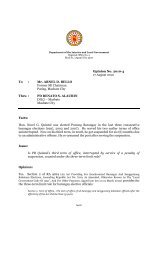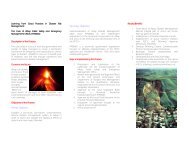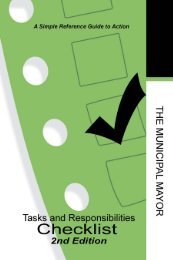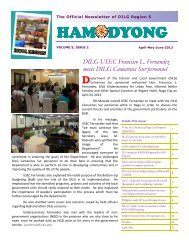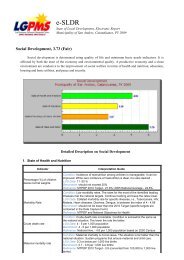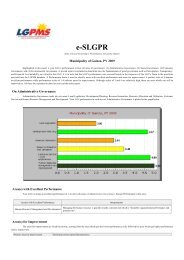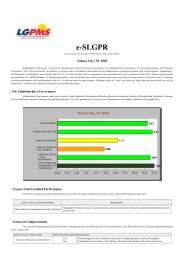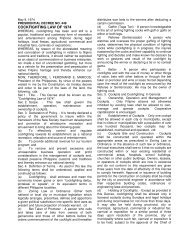A Guidebook on Capacity Development Agenda Formulation
A Guidebook on Capacity Development Agenda Formulation
A Guidebook on Capacity Development Agenda Formulation
You also want an ePaper? Increase the reach of your titles
YUMPU automatically turns print PDFs into web optimized ePapers that Google loves.
(2010 Revised Editi<strong>on</strong>)
(2010 Revised Editi<strong>on</strong>)
C<strong>on</strong>tentsForewordPrefaceAcr<strong>on</strong>yms1234Managing Knowledge for ImprovedPerformance in Local Governance<strong>Capacity</strong> <strong>Development</strong> : A New Perspective7 Steps in <strong>Capacity</strong> <strong>Development</strong><strong>Agenda</strong> Formulati<strong>on</strong>Taking Up the Challenge toInstituti<strong>on</strong>alize Change13253559Annex in a CD
Acr<strong>on</strong>ymsCBMSCDCDP-ELACIDACLUPDILGGeRL Ka Ba?KCOKMLGALGOOsLGPMSLGRCLGNRCLGSP IILGUSCALOGSLGRTWGUNDPCommunity Based M<strong>on</strong>itoring System<strong>Capacity</strong> <strong>Development</strong>Comprehensive <strong>Development</strong> Plan- Executive and Legislative <strong>Agenda</strong>Canadian Internati<strong>on</strong>al <strong>Development</strong> AgencyComprehensive Land Use PlanDepartment of the Interior and Local GovernmentGender Resp<strong>on</strong>sive LGU Ka Ba?Knowledge Centric Organizati<strong>on</strong>Knowledge ManagementLocal Government AcademyLocal Government Operati<strong>on</strong>s OfficersLocal Governance Performance Management SystemLocal Governance Resource CenterNati<strong>on</strong>al Local Governance Nati<strong>on</strong>al Resource CenterPhilippines-Canada Local Government Support Program Phase IILocal Government UnitSystems <strong>on</strong> Competency Assessment for Local GovernmentsState of Local Governance ReportTechnical Working GroupUnited Nati<strong>on</strong>s <strong>Development</strong> Programme
1NanManaging Knowledge for Improved Performancein Local Governanceet ipsa scientia potestas est.Knowledge is powerOscar Sir Francis Bac<strong>on</strong>
10A Word <strong>on</strong> Knowledge Management and Good Local GovernanceKnowledge Management or KM is theacquisiti<strong>on</strong>, storage, retrieval, creati<strong>on</strong>,sharing, use, applicati<strong>on</strong> and review of agroup or organizati<strong>on</strong>’s explicit and tacitknowledge in a systematic manner to achieveorganizati<strong>on</strong>al goals.Knowledge is informati<strong>on</strong> that isprocessed with experience andassumpti<strong>on</strong>s and applied foreffective acti<strong>on</strong>.Knowledge Management is about gettingthe right knowledge to the right peopleat the right time.KM is not <strong>on</strong>ly about informati<strong>on</strong> in itsvarious physical forms. It also includestacit knowledge, which is intangibleand resides as intellectual capital ofindividual experts and practiti<strong>on</strong>ers. KMis therefore also about c<strong>on</strong>necting those whoknow with those who need to know.KM offers a directi<strong>on</strong> for organizati<strong>on</strong> to:- manage informati<strong>on</strong> andknowledge that it knows italready has- manage knowledge that itdoes not yet know that it has- create new knowledge orinnovateWhat is the value ofmanaging knowledge inpromoting excellence inlocal governance?One of the key principles in goodgovernance is promoting a culture of selfassessmentfor improved local governmentmanagement and performance. The localgovernance sector should increasingly have
1Managing Knowledge for ImprovedPerformance in Local Governance11Figure 1Knowledge Management(in the c<strong>on</strong>text of actual governance and public administrati<strong>on</strong> processes)the capacity to learn from itself andharness the incremental less<strong>on</strong>s learnedfor more effective, efficient andresp<strong>on</strong>sive governance. And knowledge,when created, shared, applied andused, has a far-reaching influence indeveloping a culture of learning in localgovernance.<strong>Capacity</strong> <strong>Development</strong> Planning is aprocess that involves the utilizati<strong>on</strong> ofknowledge for improved LGUperformance. It is about acquiring,analyzing, sharing and using vitalknowledge in order to strategicallyaddress competency gaps andorganizati<strong>on</strong>al weaknesses so thatimproved capacity is able to input orlead to strengthened LGUperformance.M/EParticipati<strong>on</strong>Situati<strong>on</strong>alAnalysisKnowledgeImplementati<strong>on</strong>PerformancePlanningPolicy <strong>Development</strong>ProgrammingBudgetingPartnershipFor a more comprehensive informati<strong>on</strong> <strong>on</strong> knowledge managementin local governance, refer to the Annex with CD versi<strong>on</strong> ofCommunities that Learn! A Local Governance KnowledgeManagement Framework.
12DILG and LGA as Knowledge-Centric Organizati<strong>on</strong>s:Synergy, C<strong>on</strong>vergence and Innovati<strong>on</strong>The support of the Department of theInterior and Local Government (DILG) tothe local government sector hasc<strong>on</strong>siderably evolved over the last few years. Theoverall comm<strong>on</strong> thread, however, has been <strong>on</strong>e ofDILG taking a str<strong>on</strong>ger leadership role in thecoordinati<strong>on</strong> of issues affecting local governancewith a general shift from regulati<strong>on</strong> andsupervisi<strong>on</strong> to coordinati<strong>on</strong> and facilitati<strong>on</strong>. Infulfilling its mandate as a catalyst for excellencein local governance, DILG has been practicingKnowledge Management through its numerousinitiatives without necessarily labeling it as such.The use of LGU performance data, theidentificati<strong>on</strong>, documentati<strong>on</strong> and replicati<strong>on</strong> ofexemplary practices, the enhancement of localplanning system based <strong>on</strong> the feedback andexperiences of local governments and otherstakeholders, the establishment of the LocalGovernance Resource Centers (LGRCs) across thecountry, and the c<strong>on</strong>vergence and synergy of localgovernance initiatives within the DILG and withother nati<strong>on</strong>al government agencies are allexamples of KM in acti<strong>on</strong>. As the training arm ofDILG and the Nati<strong>on</strong>al Local Governance Nati<strong>on</strong>alResource Center (LGNRC), the Local GovernmentAcademy (LGA) is a knowledge hub as it plays alead role in building capacity developmentprograms and strategies for local governments andDILG pers<strong>on</strong>nel.KM is a way of doing things. DILG as anorganizati<strong>on</strong> effectively integrating KM in itsoperati<strong>on</strong>s becomes a Knowledge CentricOrganizati<strong>on</strong> (KCO), <strong>on</strong>e that values people andthe organized use of existing experience andinformati<strong>on</strong> to reach its goals. Ultimately, KM isnot exclusively about tools and technology butabout people and what they can and want to dowith their knowledge. KM is also a mindset thatin anchored <strong>on</strong> a culture of learning andknowledge sharing where there is no m<strong>on</strong>opoly of
1Managing Knowledge for ImprovedPerformance in Local Governance13Figure 2C<strong>on</strong>vergence in DILG Operati<strong>on</strong>s*knowledge and people are recognizedfor the value of their own c<strong>on</strong>tributi<strong>on</strong>sand encouraged to share and utilizeknowledge. With KM as a strategy, DILGis building c<strong>on</strong>vergence and synergy inits operati<strong>on</strong>s to maximize itsc<strong>on</strong>tributi<strong>on</strong> to the local governmentsector. Figure 2 illustrates how thenoti<strong>on</strong> of KM is central to DILGoperati<strong>on</strong>s as well as how many DILGfuncti<strong>on</strong>s and programsrelate to each otherand can be situated ina yearly cycle of interdependence.ValuesCulture of PerformanceParticipatory ProcessesStrategic LeadershipQUALITYSERVICESDELIVERYPARTICIPATORYPROCESSESPartnerships& ResourceProgramsManagementLGU Performance Management<strong>Capacity</strong> <strong>Development</strong>Replicati<strong>on</strong>Advocacy & Public Educati<strong>on</strong><strong>Development</strong> PlanningLocal Governance Resource CenterPerformanceManagementCULTURE OFPERFORMANCESTRONGENABLINGENVIRONMENTINNOVATION& LEARNINGLEADERSHIPStrategic Functi<strong>on</strong>sPerformance ManagementPolicy & LGU OversightPartnership &ResourceManagementPolicy & LGUOversight Key C<strong>on</strong>tributi<strong>on</strong>sExcellence in LocalGovernanceInnovati<strong>on</strong> and LearningQuality and Effective Service DeliveryStrengthened Local GovernanceEnabling Envir<strong>on</strong>ment*SOURCE: Philippines-Canada Local Government Support Program Phase II (LGSP II), Sustaining theGains of LGSP’s Support to the DILG and Partners, August 2006, Pasig City, Philippines
14In keeping with the thrust to buildc<strong>on</strong>vergence in its operati<strong>on</strong>s, DILGdeveloped an integrative strategy in itsvarious program designed to buildingcapacities of local governments forimproved performance.The objectives of the framework are:Harm<strong>on</strong>ize capacity developmentinterventi<strong>on</strong>s for local governmentsEnsure integrated programimplementati<strong>on</strong>Maximize the impact of DILGinterventi<strong>on</strong>sThe integrative framework in buildingLGU capacities is underpinned <strong>on</strong> keyKM principles of harm<strong>on</strong>izati<strong>on</strong> andc<strong>on</strong>vergence. It promotes establishingsynergy in the implementati<strong>on</strong> ofvarious programs and in the utilizati<strong>on</strong>of the wide range of tools andprocesses. It encourages the vigorousutilizati<strong>on</strong> of performance management andinstituti<strong>on</strong>al competency assessment tools andsystematic weaving of the results for a morein-depth and meaningful analysis.The comp<strong>on</strong>ents of the IntegrativeFramework are the following:1234Assessment of LGU Performance andInstituti<strong>on</strong>al CompetenciesCrafting of the Executive andLegislative <strong>Agenda</strong>Provisi<strong>on</strong> of <strong>Capacity</strong> <strong>Development</strong>Initiatives via the DILG LocalGovernance Resource CentersSupport ProgramsThe State of Local Governance Report (SLGR)using the Local Governance PerformanceManagement System (LGPMS) and CommunityBased M<strong>on</strong>itoring System (CBMS) resultsprovide the invaluable technical inputs to theprocess of formulating the Executive andLegislative <strong>Agenda</strong> (ELA) and the <strong>Capacity</strong><strong>Development</strong> <strong>Agenda</strong> (CD <strong>Agenda</strong>). Further,assessment tools, such as the System <strong>on</strong>Competency Assessment for LocalGovernments (SCALOG) and GeRL Ka ba?, areharnessed in <strong>Capacity</strong> <strong>Development</strong> Planningand formulating a <strong>Capacity</strong> <strong>Development</strong><strong>Agenda</strong>.With the establishment of the LocalGovernance Resource Centers (LGRCs) inDILG, a dynamic venue has been established tofacilitate the provisi<strong>on</strong> of capacitydevelopment for local governments moreefficiently and strategically. It is also seen asthe mechanism that would assist and facilitatethe implementati<strong>on</strong> of the <strong>Capacity</strong><strong>Development</strong> <strong>Agenda</strong> of LGUs through its fourdynamic services:1) Multi-media Knowledge and informati<strong>on</strong>2) <strong>Capacity</strong> <strong>Development</strong>3) Linkage and4) Public Educati<strong>on</strong> and Citizenship Programs.For more informati<strong>on</strong> <strong>on</strong> the LGRCs, visitwww.lgrc.lga.gov.ph
1Managing Knowledge for ImprovedPerformance in Local Governance15Figure 3LGU <strong>Capacity</strong> <strong>Development</strong>DILG Integrative StrategyDILG Training ProgramsOther NGA Initiated ProgramsAccredited Training ProgramsOverseas Assistance <strong>Development</strong> ProgramsAssessment of LGUPerformanceandInstituti<strong>on</strong>alCompetenciesLGPMS, CBMS,SCALOG,GeRL Ka Ba?Other toolsProvisi<strong>on</strong> of<strong>Capacity</strong><strong>Development</strong>Interventi<strong>on</strong>LGRCSLGRLGUCompetencyProfileELACDAGENDAPreparati<strong>on</strong>of theExecutive-Legislative<strong>Agenda</strong>CDP Review ELA Coaching
16Locating the DILG Local Government Operati<strong>on</strong>s Officers(LGOOs) in Knowledge Managements catalysts for excellence in local governance,LGOOs have a key role in promoting the cultureAof learning for excellence in local governance as they buildlinkages and networks, and facilitate the process ofknowledge sharing and utilizati<strong>on</strong> in their respectiveareas. LGOOs are strategic knowledge brokers who canhelp transform and apply data and informati<strong>on</strong> foreffective and resp<strong>on</strong>sive acti<strong>on</strong>.As a knowledge-centric organizati<strong>on</strong>, there is a need forDILG to generate knowledge, be able to share it and ensurethat knowledge is utilized to produce results. This willstrengthen DILG’s role as a primary catalyst, knowledgebroker and facilitator of capacity development towardsexcellence in local governance.
1Managing Knowledge for ImprovedPerformance in Local Governance17Figure 4Knowledge Management in DILGLGExcellenceLearn and InnovateEvaluateKnowledge Providers(LGU, NGA, Experts, Practiti<strong>on</strong>ers)CreateKnowledge BrokersDILG, LGOOs, LGAUtilizeKnowledge Users(LGU, Citizens, NGOs, CSOs)Share
18About the <str<strong>on</strong>g>Guidebook</str<strong>on</strong>g>: A Knowledge Tool in <strong>Capacity</strong> <strong>Development</strong> PlanningThis <str<strong>on</strong>g>Guidebook</str<strong>on</strong>g> is a simple, step-bystepguide for formulating a genderresp<strong>on</strong>sive and competency-basedLocal Government (LGU) <strong>Capacity</strong><strong>Development</strong> <strong>Agenda</strong>.It is a reference for LGOOs in coaching LGUsand their ELA teams in developing a <strong>Capacity</strong><strong>Development</strong> <strong>Agenda</strong> to more effectivelyand meaningfully address LGU priorities andprogram, as defined in the LGU localdevelopment plans such as the ELA.<strong>Capacity</strong> <strong>Development</strong> Planning is not new toLGUs. It is an important aspect of localdevelopment planning, which includes theformulati<strong>on</strong> of the Comprehensive Land UsePlan (CLUP), the Comprehensive<strong>Development</strong> Plan (CDP) and the Executiveand Legislative <strong>Agenda</strong> (ELA). While thereare guides for all these various plans, therewas a need for a tool that would systematicallyassess organizati<strong>on</strong>al competencies of localgovernments. The LGA, with support from theUnited Nati<strong>on</strong>s <strong>Development</strong> Programme(UNDP), developed the Systems <strong>on</strong> CompetencyAssessment for Local Government (SCALOG),which enables LGUs to evaluate theirorganizati<strong>on</strong>al competencies. The SCALOGallows the LGUs to systematically c<strong>on</strong>duct aself-assessment and analyze strengths andweaknesses in terms of the LGUs set of workprocesses, structures, systems andtechnologies in order to sustain or furtherimprove performance and organizati<strong>on</strong>al orinstituti<strong>on</strong>al capacity.
1Managing Knowledge for ImprovedPerformance in Local Governance19This tool is a compani<strong>on</strong> piece of theSCALOG Manual and the Manual <strong>on</strong> LocalPlanning Process: Focus <strong>on</strong> the CDP andELA. The steps in this guidebook take offfrom the SCALOG process and results,which are informed and guided by theLGPMS. LGPMS and SCALOG provide usefuldata and informati<strong>on</strong> that can be utilizedfor an in depth analysis of an LGU’s stateof local governance, its developmentadministrati<strong>on</strong> program and instituti<strong>on</strong>alcapacity.In additi<strong>on</strong> to LGPMS and SCALOG, theformulati<strong>on</strong> of a capacity developmentagenda also takes into c<strong>on</strong>siderati<strong>on</strong>results of other tools that may be used toassess organizati<strong>on</strong>al competencies andenrich the results in undertaking SCALOG.The range of tools, when utilized together,will be beneficial to the local governmentsin determining capacity developmentprioritiesAssessing organizati<strong>on</strong>al competencies is acrucial aspect in the process offormulating an LGU short term plan suchas an ELA. Thus, this guidebook is also animportant and useful material in thec<strong>on</strong>text of local development planning,specifically in formulating a CDP or anELA, which provides the strategic basis foridentifying priority capacity developmentagenda. In particular, this guidebooksupports the secti<strong>on</strong> <strong>on</strong> Determining<strong>Capacity</strong> <strong>Development</strong> Needs for PlanImplementati<strong>on</strong> or Step 6 in the ELAprocess. The <strong>Capacity</strong> <strong>Development</strong><strong>Agenda</strong> will help define the necessarycapacity requirements for effective andefficient implementati<strong>on</strong> of the priorityLGU programs and projects.This learning tool is primarilydesigned for Local GovernmentOperati<strong>on</strong>s Officers LGOOs of theDILG at the regi<strong>on</strong>al, provincial, cityand municipal levels as they play therole of knowledge brokers andfacilitators of capacity developmentin local governance and as theyengage in coaching local governmentsfor improved performance.The samples cases illustrated in this<str<strong>on</strong>g>Guidebook</str<strong>on</strong>g> are actual results of theprocess undertaken by an LGU andfor purposes of this <str<strong>on</strong>g>Guidebook</str<strong>on</strong>g> islabeled as LGU XYZ (located inRegi<strong>on</strong> 3).
<strong>Capacity</strong> <strong>Development</strong>: A New Perspective2The<strong>on</strong>ly way to make sense out of change is to plungeinto it, move with it, and join the dance.Alan W. Watts
22<strong>Capacity</strong> <strong>Development</strong> DefinedWhat is capacity and capacity development?It is important to better understandcapacity development to c<strong>on</strong>textualize<strong>Capacity</strong> <strong>Development</strong> Planning in localgovernance. The evolving definiti<strong>on</strong> ofcapacity development includes thefollowing:· <strong>Capacity</strong> development is “… any system,effort or process… which includes am<strong>on</strong>g itsmajor objectives strengthening thecapability of elected chief executiveofficers, chief administrative officers,department and agency heads andprogramme manager in general purposegovernment to plan, implement, manageor evaluate policies, strategies orprograms designed to impact <strong>on</strong> socialc<strong>on</strong>diti<strong>on</strong>s in the community.” (Cohen,1993).· <strong>Capacity</strong> strengthening is an <strong>on</strong>goingprocess by which people and systems,operating within dynamic c<strong>on</strong>texts,enhance their abilities to develop andimplement strategies in pursuit oftheir objectives for (Lusthaus et al.for IDRC, 1995).· <strong>Capacity</strong> building is any support thatstrengthens an instituti<strong>on</strong>’s ability toeffectively and efficiently design,implement and evaluate developmentactivities according to its missi<strong>on</strong>(UNICEF Namibia, 1996).· <strong>Capacity</strong> building is a process by whichindividuals, groups, instituti<strong>on</strong>s,organizati<strong>on</strong>s and societies enhancetheir abilities to identify and meetdevelopment challenges in asustainable manner. (CIDA, 1996)
2<strong>Capacity</strong> <strong>Development</strong>:A New Perspective23· <strong>Capacity</strong> development is a process bywhich individuals groups,organizati<strong>on</strong>s, instituti<strong>on</strong>s andsocieties increase their abilities toperform functi<strong>on</strong>s, solve problemsand achieve objectives; tounderstand and deal with theirdevelopment need in a broaderc<strong>on</strong>text and in a sustainable manner”(UNDP, 1997)· <strong>Capacity</strong> development is a c<strong>on</strong>ceptwhich is broader than organizati<strong>on</strong>aldevelopment since it includes anemphasis <strong>on</strong> the overall system,envir<strong>on</strong>ment or c<strong>on</strong>text within whichindividuals, organizati<strong>on</strong>s andsocieties operate and interact (andnot simply a single organizati<strong>on</strong>).(UNDP, 1998)· <strong>Capacity</strong> is the combinati<strong>on</strong> ofpeople, instituti<strong>on</strong>s and practicesthat permits countries to reachtheir development goals …<strong>Capacity</strong> building is... investmentin human capital, instituti<strong>on</strong>s andpractices (World Bank, 1998)· <strong>Capacity</strong> is a c<strong>on</strong>diti<strong>on</strong> of a systemthat emerges out of a combinati<strong>on</strong>of attributes. It refers tocollective capabilities to act andsurvive, generate developmentresults, relate, adapt and selfrenew,and achieve coherence(Peter Morgan, European Centerfor <strong>Development</strong> PolicyManagement (EDPM) May 2006)· <strong>Capacity</strong> is the power to performtasks and produce output, todefine and solve problems, andmake informed choices (RealLavergne, CIDA)In its culminating publicati<strong>on</strong> Trekkingthe Good Local Governance Terrain:The LGSP <strong>Capacity</strong> <strong>Development</strong> Way,the Philippines-Canada LocalGovernment Support Program Phase II(LGSP II), the flagship governanceprogram of the Canadian Internati<strong>on</strong>al<strong>Development</strong> Agency (CIDA) from2000-2006, offers the view of capacitydevelopment as a complex, holisticprocess that takes place at differentlevels of the system in a web ofinterc<strong>on</strong>nectedness. It describes anopen system with the local governancestakeholder terrain at the individual,organizati<strong>on</strong>al and instituti<strong>on</strong>al levels.
24New Ways of Thinking <strong>on</strong> <strong>Capacity</strong> <strong>Development</strong>*According to LGSP II, capacitydevelopment promotes excellence inlocal governance by enhancing the abilityof people to improve processes,maximize opportunities, harness andmanage resources, and develop potentialfor sustainable growth 1New ways of thinking <strong>on</strong> capacitydevelopment has expanded bey<strong>on</strong>dstaff training to include thedevelopment of public organizati<strong>on</strong>sand the enabling envir<strong>on</strong>ment, apartfrom building individual capacities anddeveloping leadership capacities inlocal governance.Element Old NewChange Unit Individual Individual, Organizati<strong>on</strong> and SystemMethod Build knowledge and skills Apply knowledge and skillsDesign Basis Individual Needs Organizati<strong>on</strong>al and System PrioritiesEmphasis Learner’s Abilities Learning Envir<strong>on</strong>mentAnalysis Strengths and Weaknesses Performance and ResultsInterventi<strong>on</strong> Series of Activities Change processBeneficiaries Beneficiary Participati<strong>on</strong> Beneficiary ownershipExpertise Externel soluti<strong>on</strong>s Local soluti<strong>on</strong>sScope Organizati<strong>on</strong> Specific Sector SpecificPrinciple C<strong>on</strong>sultati<strong>on</strong> Coordinati<strong>on</strong> and Collaborati<strong>on</strong>*Source: Trekking for Good Local Governance Terrain: The LGSP <strong>Capacity</strong> <strong>Development</strong> Way, The Philippines-CanadaLocal Government Support Program Phase II (LGSP II), 2006, Pasig City, Philippines.For more comprehensive informati<strong>on</strong> <strong>on</strong> the LGSP <strong>Capacity</strong> <strong>Development</strong>Framework, CD strategies that worked, less<strong>on</strong>s learned and results, seeenclosed CD <strong>on</strong> Trekking the Good Local Governance Terrain:The LGSP <strong>Capacity</strong> <strong>Development</strong> Way.1Red Batario, et al. Trekking the Good Local Governance Terrain: The LGSP <strong>Capacity</strong> <strong>Development</strong> Way, Philippines-CanadaLocal Government Support Program, 2006, Manila, Philippines, p.20.
2<strong>Capacity</strong> <strong>Development</strong>:A New Perspective25Why a <strong>Capacity</strong> <strong>Development</strong> (CD) <strong>Agenda</strong>?Who is it for? What is it for?apacity <strong>Development</strong> becomesstrategic if it is based <strong>on</strong> a Cstrategic plan of an LGU such as aComprehensive <strong>Development</strong> Plan (CDP) oran Executive and Legislative <strong>Agenda</strong> (ELA).Any effort to improve LGU capacity shouldbe geared towards c<strong>on</strong>tributing to theattainment of its development objectivesand goals. 2A <strong>Capacity</strong> <strong>Development</strong> <strong>Agenda</strong> outlinesthe capacity development strategies,programs and initiatives that need to beundertaken to address identifiedorganizati<strong>on</strong>al competency gaps, indicatingthe target groups, specific recommendedapproaches, resources required andtimeline.The development of a gender resp<strong>on</strong>sive andcompetency-based LGU <strong>Capacity</strong> <strong>Development</strong><strong>Agenda</strong> aims to:Define the necessary capacity requirementsfor a gender resp<strong>on</strong>sive, effective andefficient implementati<strong>on</strong> of the priority LGUprograms and projectsHelp rati<strong>on</strong>alize and strategically focuscapacity development efforts of the LGUProvide DILG/LGA and other localgovernance stakeholders with necessaryinformati<strong>on</strong> that will facilitate delivery ofnecessary technical assistance and supportto LGUsFacilitate knowledge capital planning andbuild- up in the LGU and the DILG LocalGovernance Resource Center, providing aresp<strong>on</strong>sive, efficient and accessibleenvir<strong>on</strong>ment for addressing LGU knowledgeand capacity requirements1Maria C<strong>on</strong>cepci<strong>on</strong> Pabalan, et al. How to Formulate an Executive and Legislative <strong>Agenda</strong> for LocalGovernance and <strong>Development</strong>: Facilitator’s Guide, Philippines-Canada Local Government SupportProgram, 2004, Manila, Philippines.
26In undertaking the process of capacitydevelopment planning and informulating a capacity developmentagenda, it is important to take intoc<strong>on</strong>siderati<strong>on</strong> the following principles:12Maximize the utilizati<strong>on</strong> ofappropriate performancemanagement and instituti<strong>on</strong>alcompetency assessment toolsDo not limit analysis with the useof <strong>on</strong>e tool or process. Correlateand validate results with othercompetency assessment tools for amore in-depth and accurateanalysis.Mainstream gender andparticipatory governanceprocesses in capacity developmentplanning.SCALOG integrates participatoryprocesses such as dialogues,c<strong>on</strong>sultati<strong>on</strong>s and c<strong>on</strong>sensusbuildingin identifying34organizati<strong>on</strong>al strengths and weaknesses ofLGUs. The use of “GeRL Ka Ba?”, al<strong>on</strong>gsideSCALOG, as a capacity development selfassessmenttool allows for a systematicintegrati<strong>on</strong> of gender in the <strong>Capacity</strong><strong>Development</strong> <strong>Agenda</strong>.Include all five (5) LGPMS and SCALOGPerformance Areas in <strong>Capacity</strong> <strong>Development</strong>Planning.All fourteen (14) Service Areas under thefive (5) Performance Areas should beassessed. A <strong>Capacity</strong> <strong>Development</strong> <strong>Agenda</strong>may include all performance and serviceareas, including both areas of strengths andweaknesses. The CD <strong>Agenda</strong> will be good forthree years, aligned with the LGU’s shortterm plan such as the ELA and will also bethe basis for the annual priorities of the LGUas articulated in the annual investment plan.Integrati<strong>on</strong> and C<strong>on</strong>vergence are importantin <strong>Capacity</strong> <strong>Development</strong> Planning.<strong>Capacity</strong> <strong>Development</strong> planning andformulati<strong>on</strong> of the CD <strong>Agenda</strong> is not to betaken separately from other instituti<strong>on</strong>alized
2<strong>Capacity</strong> <strong>Development</strong>:A New Perspective27Figure 5Knowledge Management and <strong>Capacity</strong> <strong>Development</strong> Planninglocal governance programs such as5LGPMS, ELA,GO-FAR and LocalGovernance Knowledge Management.Integrati<strong>on</strong> is key in the process ofdeveloping a meaningful and relevant<strong>Capacity</strong> <strong>Development</strong> <strong>Agenda</strong> forimproved performance of an LGU.Disjointed plans will most likely leadto waste of resources and problematicgovernance and development results.Build c<strong>on</strong>sensus am<strong>on</strong>g developmentpartners in defining the kind andextent of capacity developmentIt is important in capacitydevelopment planning to determinethe answers to the followingquesti<strong>on</strong>s:EvaluateELA Report BackCD <strong>Agenda</strong> M/ELGExcellenceLearn and InnovateKnowledge Providers(LGU, NGA, Experts, Practiti<strong>on</strong>ers)Knowledge BrokersDILG, LGOOs, LGACreateLGPMSSCALOGWhat capacity is needed by whomand for what purpose?How will the capacities be developedand exercised over time?UtilizeCDP-ELACD <strong>Agenda</strong>Knowledge Users(LGU, Citizens, NGOs, CSOs)ShareSLGR
28The Role of DILG Local Government Operati<strong>on</strong>s Officers in<strong>Capacity</strong> <strong>Development</strong> Plannings facilitators of capacity development in local governance, the DILG LocalGovernment Operati<strong>on</strong>s Officers (LGOOs) play a central role in theAformulati<strong>on</strong> of a <strong>Capacity</strong> <strong>Development</strong> <strong>Agenda</strong> for local governments. The followingare important c<strong>on</strong>siderati<strong>on</strong>s for LGOOs in order to maximize their role effectivelyin undertaking and facilitating the process:1LGOOs must have a working knowledge of a whole range of local governancemanagement and planning systems, processes and tools such as LGPMS, CDP,ELA, LGU Organizati<strong>on</strong>al Competency Assessment, CBMS and Gerl Ka Ba?234LGOOs must be well versed with problem analysis tools such as Problem Tree,Objective Tree, Fishb<strong>on</strong>e and Force Field Analysis am<strong>on</strong>g others and able toundertake and facilitate data analysis and validati<strong>on</strong>LGOOs must have a solid grasp of capacity development and its emergingprinciples and strategies as applied to local governanceTake the lead in facilitating the preparatory steps for the c<strong>on</strong>duct of the<strong>Capacity</strong> <strong>Development</strong> (CD) Planning and <strong>Agenda</strong> Formulati<strong>on</strong>.
2<strong>Capacity</strong> <strong>Development</strong>:A New Perspective29567This includes the following important tasks:Organizati<strong>on</strong> of the LGU Technical Working Group (TWG) resp<strong>on</strong>sible for the CDPlanning and <strong>Agenda</strong> Formulati<strong>on</strong>Data management, which requires that relevant and up-to-date data for theprocess is available, secured and validatedCompleti<strong>on</strong> of SCALOG processFacilitate the actual c<strong>on</strong>duct of the CD Planning and <strong>Agenda</strong> Formulati<strong>on</strong>LGOOs may act as the facilitator in some casesor as a coach to the LGU Technical WorkingGroup when it takes the lead in c<strong>on</strong>ductingthe processEnsure that a debriefing takes place with the LGU Technical Working Group (TWG) atthe end of the process to validate results.Facilitate the disseminati<strong>on</strong> of the LGU <strong>Capacity</strong> <strong>Development</strong> <strong>Agenda</strong> as appropriatewithin the LGU and to external partners, such as the Local Governance Resource CenterLGRC.
7 Steps in <strong>Capacity</strong> <strong>Development</strong> <strong>Agenda</strong> Formulati<strong>on</strong>3Tobe prepared is half the victory.Miguel de Cervantes
9 Steps in <strong>Capacity</strong> <strong>Development</strong>3 <strong>Agenda</strong> Formulati<strong>on</strong>33Before You Start!The following are prerequisites in undertaking the 7 steps:1. The LGU should have completed their:o State of Local Governance Report (SLGR) as anoutput of the Local Governance PerformanceManagement System (LGPMS) tool.o SCALOG: LGU Organizati<strong>on</strong>al CompetencyAssessment result with the LGU Organizati<strong>on</strong>alCompetency Profile as an output.2. It may also help to make readily <strong>on</strong> hand results of otherperformance assessment tools (e.g. CBMS, GeRL Ka ba?) as theinformati<strong>on</strong> they offer may be crucial in successfully completing theprocess.3. An LGU Technical Working Group (TWG) has been organized andoriented with the new ways of thinking <strong>on</strong> <strong>Capacity</strong> <strong>Development</strong>.Together with the MLGOO, they should also have with a solid graspof the result of these assessment tools.4. The Comprehensive <strong>Development</strong> Plan (CDP) – Executive andLegislative <strong>Agenda</strong> (ELA) must also be reviewed as the CapDev<strong>Agenda</strong> represents the Instituti<strong>on</strong>al <strong>Capacity</strong> Sector of the CDP-ELA.Some c<strong>on</strong>siderati<strong>on</strong>s in organizing themembers of an LGU Technical WorkingGroup :LCE to issue an Executive Ordercreating the LGU Technical WorkingGroup preferably composed of thefollowing:oooooHead of Human ResourceDepartment, as <strong>Capacity</strong><strong>Development</strong> <strong>Agenda</strong>Focal Pers<strong>on</strong> and Head ofthe TWG;City/Municipal Planning<strong>Development</strong>Coordinator, as LGPMSand SCALOG Focal Pers<strong>on</strong> ;City/MunicipalAdministratorOther Department HeadsELA Coordinator
34There is no “<strong>on</strong>e way” to formulate a CD <strong>Agenda</strong>. The following are suggested steps with corresp<strong>on</strong>ding tools inc<strong>on</strong>ducting <strong>Capacity</strong> <strong>Development</strong> Planning and <strong>Agenda</strong> Formulati<strong>on</strong>.7 Steps in <strong>Capacity</strong> <strong>Development</strong> <strong>Agenda</strong> Formulati<strong>on</strong>Step 1Determine the Current Situati<strong>on</strong>Closely review the LGU Organizati<strong>on</strong>al Competency Profile (Appendix B of SCALOG-LOCA) and compare results with the indicators forc<strong>on</strong>sistency. It is important that the data entered herein is validated.Focus <strong>on</strong> the list of competency strengths and gaps as summarized in the LGU Organizati<strong>on</strong>al Competency Profile. Form No. 1 as illustrated,indicates the list of competency strengths and gaps per competency area.Form 1: Organizati<strong>on</strong>al Assessment ResultORGANIZATIONAL ASSESSMENT RESULTMunicipality XYService AreasHigh competencyCompetency Assessment Result (7 competency areas)Low CompetencyNote:High Competency- 3.5 - 5.0Low Competency- 1.0 - 3.49SOCIAL GOVERNANCEPeace, Security and DisasterPreparednessOrganizati<strong>on</strong> & staffingLegislative & otherenabling mecTransparencyMngt. SystemCustomer ServiceThe LGU streamlines its peace, security and disaster preparednessservices in terms of reducti<strong>on</strong> in:3.4.7.2.1 processing/transacti<strong>on</strong> time3.4.7.2.2 number of requirements3.4.7.2.3 number of signatories3.4.7.2.4 number of stepsThe LGU solicits feedback from its clients regarding its services throughinformal means (e.g., sp<strong>on</strong>taneous feedback from clients, interviews andother methods that are unstructured or d<strong>on</strong>e randomly)Participati<strong>on</strong>Lesser participati<strong>on</strong> of the community in planning, projectimplementati<strong>on</strong>,m<strong>on</strong>itoring & evaluati<strong>on</strong>.
37 Steps in <strong>Capacity</strong> <strong>Development</strong><strong>Agenda</strong> Formulati<strong>on</strong>35Step 2Validate LGU Competency gaps with reference to othertools that generate LGU data and informati<strong>on</strong>.The intenti<strong>on</strong> in undertaking this step is to establish thec<strong>on</strong>sistency of SCALOG results with other analysis.It should be noted that the LGU <strong>Capacity</strong> <strong>Development</strong> <strong>Agenda</strong> is an integral part of the Executive-Legislative <strong>Agenda</strong>. This undertaking should have c<strong>on</strong>sidered the following Calendar in administeringassessment tools and instruments and the formulati<strong>on</strong> of the plan:• LGPMS Data Gathering and Analysis - January to end of February• Presentati<strong>on</strong> of LGPMS Result - <strong>on</strong> or before March 31• SCALOG Administrati<strong>on</strong> and Analysis - April• ELA Preparati<strong>on</strong> Steps 1-5- July to AugustSome of the tools and processes that may be used to correlate SCALOG results and enrich the qualitativeanalysis further are CBMS, GeRL Ka Ba? and other tools focused <strong>on</strong> assessing child-friendly LGUs,envir<strong>on</strong>mental impact and evaluating LGU financial management, am<strong>on</strong>g others.Form No. 2Performance IndexLOCAL GOVERNANCE PERFORMANCE MANAGEMENT SYSTEM (LGPMS) ResultMUNICIPALITY XYForm No. 2 illustrates the performancegaps as captured under the LocalGovernance Performance ManagementSystem and describes the factorsaffecting low performance.Service AreasPerformanceRatingPerformanceIndex (AdjectivalRating)Factors Affecting PerformanceSOCIAL GOVERNANCEPeace, Security andDisaster Preparedness3.60 FairPartial functi<strong>on</strong>ality of POCPOC does not meet as often as necessaryLesser quality of IACPSPPartial participati<strong>on</strong> in IAPSP formulati<strong>on</strong>Partial participati<strong>on</strong> in IASCP formulati<strong>on</strong>No M & E for IAPSP
36Form No. 3 correlates existingCDP-ELA sectoral objectivesvis-à-vis performance areas/service areasForm No. 3CDP-ELA ObjectivesSECTORAL OBJECTIVES (REVISITING EXECUTIVE-LEGISLATIVE AGENDA (ELA))MUNICIPALITY XYPerformance Areas /Service AreasGoals (Performance Areas)ELA Dev’t. Goals/ObjectivesSectoral objectives (Service Areas)SOCIAL SERVICESPeace, Security & Disaster Prep.A peaceful and safe community
37 Steps in <strong>Capacity</strong> <strong>Development</strong><strong>Agenda</strong> Formulati<strong>on</strong>37Form No. 4CDP-ELA-LGPMS-SCALOG COMPLMENTATIONForm No. 4 establishes relati<strong>on</strong>ships andprovides for the complementati<strong>on</strong> of theresults of the different tools andprocesses to enrich the qualitativeanalysis for each performance area/service area.CDP-ELA-LGPMS-SCALOG COMPLMENTATIONMUNICIPALITY XYPerformance Areas /Service AreasCDP/ELA (SectoralObjectivesPerformance Index(Weak performance areas)Low CompetencySOCIAL GOVERNANCEPeace, Security & Disaster Prep.Peaceful andsafe communityFairPOC does not meet as often asnecessaryPartial participati<strong>on</strong> in IAPSPformulati<strong>on</strong>Partial participati<strong>on</strong> in IASCPformulati<strong>on</strong>Customer ServiceThe LGU streamlines its peace, security anddisaster preparedness services in terms ofreducti<strong>on</strong> in:3.4.7.2.1 processing/transacti<strong>on</strong> time3.4.7.2.2 number of requirements3.4.7.2.3 number of signatories3.4.7.2.4 number of stepsNo M & E for IAPSPThe LGU solicits feedback from its clientsregarding its services through informal means(e.g., sp<strong>on</strong>taneous feedback from clients,interviews and other methods that areunstructured or d<strong>on</strong>e randomly)Participati<strong>on</strong>Lesser participati<strong>on</strong> of the community inplanning, projectimplementati<strong>on</strong>, m<strong>on</strong>itoring & evaluati<strong>on</strong>.
38Step 3Undertake analysis of theidentified problemsUse <strong>on</strong>e or a combinati<strong>on</strong> oftools and processes in analyzingthe problem/s. The suggestedtools are Problem Tree Analysis,Fishb<strong>on</strong>e Analysis, Strength,Weaknesses, Opportunities andThreat (SWOT) Analysis,Alternative Analysis Approach,Participatory IssueIdentificati<strong>on</strong>, Pairwise RankingThe Problem Tree Analysis isdiscribed in the suggestedtool #1.Suggested Tool #1PROBLEM ANALYSISUsing “metacards,”list all problems. Onecard per problem.Formulate eachproblem as anegative c<strong>on</strong>diti<strong>on</strong>.The c<strong>on</strong>vergence pointfor all the problemsidentified is referredto as the “coreproblem” & becomestheoverriding c<strong>on</strong>cernthat will have to beaddressed.How to undertake Problem analysisSTEP 1Identify theproblemsSTEP 2Establish the cause andeffect relati<strong>on</strong>shipam<strong>on</strong>g the problemsidentifiedSTEP 3Establish ac<strong>on</strong>vergencepoint/sSTEP 4Review thediagram asa whole.From am<strong>on</strong>gthe listedproblems, try& agree <strong>on</strong>which is thecause &which is theeffect.Verify the cause andeffect relati<strong>on</strong>shipand agree <strong>on</strong> thesoundness andcompleteness of theproblem tree.See Illustrati<strong>on</strong> #3 for a sample of an actual case.
39Suggested Tool # 2B. Sample Case Using SWOTSuggested Tool # 3C. Sample Case Using Fishb<strong>on</strong>e AnalysisHow to do a SWOT· Step 1 – Informati<strong>on</strong> collecti<strong>on</strong> - In the here and now…List all strengths that exist now. Then in turn, list allweaknesses that exist now. Be realistic but avoid modesty!oooYou can c<strong>on</strong>duct <strong>on</strong>e-<strong>on</strong>-<strong>on</strong>e interviews. Or get agroup together to brainstorm. A bit of both isfrequently best.You’ll first want to prepare questi<strong>on</strong>s that relateto the specific company or product that you areanalyzing. You’ll find some questi<strong>on</strong>s and issuesbelow to get you going.When facilitating a SWOT - search for insightthrough intelligent questi<strong>on</strong>ing and probing· Step 2 – What might be…List all opportunities that exist in the future. Opportunitiesare potential future strengths. Then in turn, list all threatsthat exist in the future. Threats are potential futureweaknesses.· Step 3 – Plan of acti<strong>on</strong>…Review your SWOT matrix with a view to creating an acti<strong>on</strong>plan to address each of the four areas.References:http://rapidbi.com/created/SWOTanalysis.html#Definiti<strong>on</strong>http://www.mindtools.com/pages/article/newTMC_03.htmhttp://web2.c<strong>on</strong>cordia.ca/Quality/tools/18pairwise.pdfFollow these steps to solve a problem with a Cause and Effect Diagram:1. Identify the problem:Write down the exact problem you face in detail. Where appropriateidentify who is involved, what the problem is, and when and where it occurs.Write the problem in a box <strong>on</strong> the left hand side of a large sheet ofpaper. Draw a line across the paper horiz<strong>on</strong>tally from the box. This arrangement,looking like the head and spine of a fish, gives you space todevelop ideas.2.Work out the major factors involved:Next identify the factors that may c<strong>on</strong>tribute to the problem. Drawlines off the spine for each factor, and label it. These may be people involvedwith the problem, systems, equipment, materials, external forces, etc. Tryto draw out as many possible factors as possible. If you are trying to solvethe problem as part of a group, then this may be a good time for somebrainstorming.Using the ‘Fish b<strong>on</strong>e’ analogy, the factors you find can be thought ofas the b<strong>on</strong>es of the fish.3. Identify possible causes:For each of the factors you c<strong>on</strong>sidered in stage 2, brainstorm possiblecauses of the problem that may be related to the factor. Show these assmaller lines coming off the ‘b<strong>on</strong>es’ of the fish. Where a cause is large orcomplex, then it may be best to break the it down into sub-causes. Showthese as lines coming off each cause line.4. Analyze your diagram:By this stage you should have a diagram showing all the possiblecauses of your problem that you can think of. Depending <strong>on</strong> the complexityand importance of the problem, you can now investigate the most likelycauses further. This may involve setting up investigati<strong>on</strong>s, carrying out surveys,etc. These will be designed to test whether your assessments are correct.
40Step 4 Formulate the Competency Objectives .Obejctives are specific measures used todetermine whether or not we are successfulin achieving a goal.When sitting down to formulate your objectives,it would help to have a very clear ideaof what you want to be in the future andwhat you are going to do to get there. yourobejctives therefore should be SMART!S Specific Not a vague aspirati<strong>on</strong> but a cleardescripti<strong>on</strong> of where you want to beM Measurable So that you can dem<strong>on</strong>strate thatobjective can be achievedA Achievable Within your c<strong>on</strong>trol of influenceR Resourced Clearly linked to the resources neededto get you where you want to beThe objective analysis will facilitate theidentificati<strong>on</strong> of the Core CompetencyObjective for <strong>Capacity</strong> <strong>Development</strong> (CD).Hence, it is str<strong>on</strong>gly suggested that the useof Problem Tree Analysis be undertaken toidentify the problems as suggested underthe Step 3.What is Objective Analysis?It is a tool to:- describe a situati<strong>on</strong> that would existafter solving a problem or problems- Identify means-ends relati<strong>on</strong>ship tomeet the objectives- Visualize the relati<strong>on</strong>ships in a diagram.See Tool # 2 and follow the processdescribed in stepsT Time-bounded Deadline!
9 Steps in <strong>Capacity</strong> <strong>Development</strong>3 <strong>Agenda</strong> Formulati<strong>on</strong>46 41OBJECTIVE ANALYSISThe process takes offfrom the problemanalysis undertakenearlier (see SuggestedTool #1). Instruct theteam to go through thefollowing steps:Step 1: Reformulate allnegative statements in theproblem tree into positivestatementsStep 3: Reformulate CoreObjective into a CoreCompetency ObjectiveStep 2: Form a diagram showingmeans-ends relati<strong>on</strong>ship in theform of an objective tree.Step 4: Reformulate all MEANSstatements into appropriatestrategies, and END statements intoappropriate goalsStep 5: Add or do away withstrategies as appropriate.Step 6: Review the diagram as awhole and verify its validity andcompleteness.How do you identify the Core Competency Objective for CD?Translate the core objective as stated in the Objective Analysis to a specificcompetency that needs to be developed. See Illustrati<strong>on</strong> # 4 for sample ofan actual case.
42Developing Core Competency Objective for CD and Strategies Using Objective AnalysisIllustrati<strong>on</strong> No: 4Sample Case Using Objective TreeENDSAppropriate systems inplace that make use ofstaff time & resources tothe maximum &efficientlyAvailability offunds tofinancedevelopmentprojectsTaxpayers areaware ofpaymentobligati<strong>on</strong>sExpansi<strong>on</strong> ofrevenuegenerati<strong>on</strong>baseCitizens havemotivati<strong>on</strong> topay their taxesEstablishmentof a <strong>on</strong>e-stopshopWillingness oftaxpayers to payTO DEVELOP A LOCAL REVENUE PLANWITH AN UPDATED REVENUE CODECORE OBJECTIVECommunicati<strong>on</strong> Strategydeveloped to c<strong>on</strong>vincecitizens of incentives andbenefits of paying taxesEfficient systems <strong>on</strong>:-Assessment-Collecti<strong>on</strong>-Business registrati<strong>on</strong>Political will tocollect taxesMEANSThe public are informedof their resp<strong>on</strong>sibility topay their taxesLGU systemstreamlinedPresence of competentstaff complement tosupport tax collecti<strong>on</strong>initiativesTax campaigndeveloped &implementedLGU hasa public serviceorientati<strong>on</strong>Penalties arestrictlyimplementedFinancialmanagementsystemimplemented
9 Steps in <strong>Capacity</strong> <strong>Development</strong>3 <strong>Agenda</strong> Formulati<strong>on</strong>43GOALSCore CompetencyObjective for CDSTRATEGIES1. To c<strong>on</strong>vince citizens that paying taxes will improve the quality of their lives.2. To establish a <strong>on</strong>e-stop shop to enhance local revenue generati<strong>on</strong>.3. To strengthen citizenship in the area of revenue generati<strong>on</strong> in local governance.4. To expand the local revenue generati<strong>on</strong> base and identify traditi<strong>on</strong>al & n<strong>on</strong> traditi<strong>on</strong>al sourcesof income.5. To ensure that local revenue are allotted for development oriented & enhanced servicedelivery programs & projects.ENHANCE LGU CAPACITY TO STRENGTHENLOCAL REVENUE GENERATIONSTREAMLINING OF LGU SYSTEMINDIVIDUAL-Build capacity of staff to provideappropriate support to tax collecti<strong>on</strong>initiativeORGANIZATION-Develop & implement systems in place interms of assessment, collecti<strong>on</strong>, &business registrati<strong>on</strong>SYSTEM / INSTITUTIONAL-Formulate & implement local policies,i.e. Executive Order <strong>on</strong> streamlining andimplementati<strong>on</strong> of incentives andpenalties.BUILD CAPACITYOF LGU STAFF IN DEVELOPING THE LOCALREVENUE PLANDEVELOPMENT OF A COMMUNICATIONSTRATEGY aimed at:Increasing awareness of citizens and LGUleaders <strong>on</strong> the benefits of paying taxes(External & Internal buy in)Developing a public service orientati<strong>on</strong> of LGU(Internal buy in)Strengthening citizenship & public participati<strong>on</strong>Tips- Add new strategiesif there are relevant<strong>on</strong>es that come upduring thediscussi<strong>on</strong> andwould benecessary toachieve anobjective at ahigher level- Delete strategiesthat do not seem tobe necessaryas a result of thediscussi<strong>on</strong>
44Step 5Prioritize gaps for <strong>Capacity</strong> <strong>Development</strong> interventi<strong>on</strong>.Rec<strong>on</strong>cile Core Competency Objectivefor CD with the priority developmentagenda and capacity developmentrequirements as stated in the LGUSLGR, if available. Also refer to theLGU CDP-ELA and list the CDP-ELApriorities per performance area, ifavailable.This step is crucial and its purpose is toestablish the link of the identifiedcompetency gaps with the prioritydevelopment agenda of the LGU.Key Questi<strong>on</strong>s to Ask!. Are the capacity developmentrequirements identified in the SLGRc<strong>on</strong>sistent with the Core CompetencyObjective for <strong>Capacity</strong> <strong>Development</strong>?. Are the identified core competencyobjective/s for CD aligned with thethrust of improving the state of localgovernance of the LGU?. Would addressing the competencygaps c<strong>on</strong>tribute in accomplishing thepriority program, projects andactivities of the LGU as articulated inthe CDP-ELA?. Would efforts to address thecompetency gaps potentially lead toinstituti<strong>on</strong>alizing change in the LGU?
9 Steps in <strong>Capacity</strong> <strong>Development</strong>3 <strong>Agenda</strong> Formulati<strong>on</strong>50 45Matrix 1Validati<strong>on</strong> MatrixLGU XYZLGU Priority <strong>Development</strong> <strong>Agenda</strong>, CDP-ELA Goals and Priorities and CoreCompetency Objective for <strong>Capacity</strong> <strong>Development</strong>Local GovernancePerformance AreasLGU Priority <strong>Development</strong><strong>Agenda</strong> as stated in the SLGR(Outcomes/Outputs)CDP- ELAPrioritiesCore Competency Objective for<strong>Capacity</strong> <strong>Development</strong> (Step 7)GovernanceAdministrati<strong>on</strong> -Revenue Generati<strong>on</strong>Enhance tax collecti<strong>on</strong> efficiency andRevenue Generati<strong>on</strong> Activities· improve the city’s coffers· computerize payment and taxcollecti<strong>on</strong> system· invest in local ec<strong>on</strong>omic revenuegenerating enterpriseUpdate theLocal revenue Code· c<strong>on</strong>duct tax mapping operati<strong>on</strong>stoestablish the tax base and identifyadditi<strong>on</strong>al taxable properties andbusinesses· expand ec<strong>on</strong>omic activitiescovered by a new tax scheme· offer better incentives toUpdate theRevenueCodeDeveloptraditi<strong>on</strong>aland n<strong>on</strong>traditi<strong>on</strong>alsources ofrevenueEnhance LGU capacity tostrengthen local revenuegenerati<strong>on</strong>Service Deliveryprospective investorsEc<strong>on</strong>omic<strong>Development</strong>Envir<strong>on</strong>mentalManagement
46Step 6Develop the <strong>Capacity</strong> <strong>Development</strong> <strong>Agenda</strong>6.4. Prioritize the capacity developmentinitiatives as High, Medium and Low toindicate which <strong>on</strong>e should be implementedfirst6.1 Organize the <strong>Capacity</strong> <strong>Development</strong> <strong>Agenda</strong> accordingto Local Governance Performance Areas6.2 Indicate Core Competency Objective for CD6.3 Identify specific and appropriate capacitydevelopment strategy/approach/initiative that needsto be taken to meet the specific objective.At this point, review results of Step 7- ObjectiveAnalysis - and look closely at the identified means to beable to meet the objectives. This secti<strong>on</strong> will provideideas <strong>on</strong> specific and appropriate capacity developmentstrategies and approachesRemember, capacity development is NOT just about trainingor staff development and may involve a whole range ofstrategies and approaches e.g. learning by doing, peer topeer mentoring, work place learning , <strong>on</strong>-site coachingam<strong>on</strong>g others.Core Competency Objective for CDand corresp<strong>on</strong>ding initiatives that arealigned with the Priority <strong>Development</strong><strong>Agenda</strong>, <strong>Capacity</strong> <strong>Development</strong>Requirements identified in the SLGRand CDP-ELA priorities should bemarked as high in the priority list.Review Matrix 1.6.5. Identify target outcomes or milest<strong>on</strong>esthat would be the basis for m<strong>on</strong>itoring andevaluati<strong>on</strong> of the results of implementingthe CD <strong>Agenda</strong>.6.6. Identify target individual, divisi<strong>on</strong>s,systems, structures and policies thatshould be primarily involved in and/orshould be addressed by the proposedcapacity development initiatives. Thesemay also include specific structures,systems and/or processes that may beinfluenced by the capacity developmentagenda and process
9 Steps in <strong>Capacity</strong> <strong>Development</strong>3 <strong>Agenda</strong> Formulati<strong>on</strong>52 476.7. Assign specific roles and resp<strong>on</strong>sibilities to achieve the capacityobjectives and targets6.8. Indicate target deadline for the completi<strong>on</strong> of each capacitydevelopment initiative6.9. Draw up realistic resource requirements and indicate fundingsources, if able to identify.Resource requirements may take various forms: human, material and m<strong>on</strong>etary.Sources may be internal (from within the LGU budget) or external.6.10. Identify potential sources of support or technical assistance.For example, the Local Governance Resource Centers may be tapped tofacilitate specific capacity development initiatives. Similarly, nati<strong>on</strong>alagencies, academia or NGOs may be harnessed. It would be helpful if theplan will indicate these potential sources of assistance.
48Remember, capacity development is NOT just about training or staff development and may involve a whole range ofstrategies and approaches e.g. learning by doing, peer to peer mentoring, work place learning, <strong>on</strong>-site coaching am<strong>on</strong>gothers.This is how a CapDev <strong>Agenda</strong> Looks like:PerformanceAreas /ServiceAreasCompetencyObjectives<strong>Capacity</strong><strong>Development</strong>Resp<strong>on</strong>ses(Strategies/ Approaches/P/P/As)EXPECTEDOUTPUTTARGET BENEFICIARIESNo.TypeLevelofPriorityTimeFrameFunding Requirement2010 2011 2012OfficeResp<strong>on</strong>sibleSource ofSupport/TechnicalAssistance
Taking Up the Challenge to Instituti<strong>on</strong>alize Change4Thebest way to predict the future is to create it…Peter Drucker
52or any local capacity development initiative to be strategic and effective, it is imperative for it to be based<strong>on</strong> the strategic plan of an LGU. Efforts to enhance LGU capacities for improved performance should bealigned with the LGU development goals and priorities. C<strong>on</strong>versely, LGU plans and priorities should beFsupported by organizati<strong>on</strong>al and instituti<strong>on</strong>al competencies for its successful implementati<strong>on</strong>.Here lies the challenge of capacity development planning. Given its crucial place in the local developmentmanagement process, it should be prioritized and integrated meaningfully and systematically in local developmentplanning. At present, capacity development planning is a less prioritized task in many LGUs. Issues around time andresources tend to set capacity development aside. Moreover, the view of capacity development as limited to trainingremoves the creativity from the process and tends to marginalize the whole range of CD strategies.Promoting the culture of learning in pursuit of good local governance entails the need to address organizati<strong>on</strong>al andinstituti<strong>on</strong>al competency gaps. LGUs should not ignore or deny any shortcomings. Rather, the opportunity to build aculture of self-assessment could not be more real and possible than now. <strong>Capacity</strong> development planning as aknowledge process is a way to improving LGU performance.It is important for an LGU to prioritize vis-à-vis a whole gamut of programs and projects when formulating a CD<strong>Agenda</strong>. For example, the Core Competency Objectives for <strong>Capacity</strong> <strong>Development</strong> that align with LGPMS results andCDP-ELA priorities must be high in the list of priorities. Moreover, the CD <strong>Agenda</strong> may also address areas that wouldhelp sustain a particular performance area and make it even better. What would it take to sustain effective systemsand make them even more resp<strong>on</strong>sive? How can it be instituti<strong>on</strong>alized?The Local Government Operati<strong>on</strong>s Officers (LGOOs) play a pivotal role in promoting a culture of learning and selfassessmentin local governance. The key is to understand what it takes to broker the knowledge created and madeavailable so that LGUs may be able to use it effectively to address their own needs and priorities. Knowledge capitalbuild-up or organizing the relevant data, informati<strong>on</strong> and knowledge needed to resp<strong>on</strong>d to the LGU CD <strong>Agenda</strong> is akey result of capacity development planning. The LGOO is in the best positi<strong>on</strong> to facilitate this process incoordinati<strong>on</strong> with the DILG Local Governance Resource Center. LGOOs have within their reach a wealth of tools andstrategies that would support LGUs craft a gender resp<strong>on</strong>sive <strong>Capacity</strong> <strong>Development</strong> <strong>Agenda</strong>.One must not want to instituti<strong>on</strong>alize change. One must choose to.




